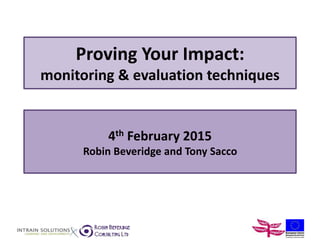This document outlines an agenda and content for a workshop on monitoring and evaluation techniques. The all-day workshop covers key concepts, logic chains, quantitative and qualitative data collection methods, quantitative evaluation techniques like sampling and extrapolation, using case studies and qualitative stories, and calculating value for money. Participants will work in groups to develop logic chains for their own projects, discuss best practices for gathering beneficiary feedback, and begin drafting an evaluation plan. The goal is to provide practical skills and strategies for organizations to effectively demonstrate their impact.





















































































